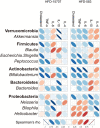In vivo Trial of Bifidobacterium longum Revealed the Complex Network Correlations Between Gut Microbiota and Health Promotional Effects
- PMID: 35783421
- PMCID: PMC9247516
- DOI: 10.3389/fmicb.2022.886934
In vivo Trial of Bifidobacterium longum Revealed the Complex Network Correlations Between Gut Microbiota and Health Promotional Effects
Abstract
Complete genome sequence analysis of Bifidobacterium longum subsp. longum BCBL-583 isolated from a Korean female fecal sample showed no virulence factor or antibiotic resistance gene, suggesting human safety. In addition, this strain has oxygen and heat tolerance genes for food processing, and cholesterol reduction and mucin adhesion-related genes were also found. For in vivo evaluations, a high fat diet (HFD) mouse model was used, showing that BCBL-583 administration to the model (HFD-583) reduced the total cholesterol and LDL-cholesterol in the blood and decreased pro-inflammatory cytokines but increased anti-inflammatory cytokines, substantiating its cholesterol reduction and anti-inflammation activities. Subsequent microbiome analysis of the fecal samples from the HFD mouse model revealed that BCBL-583 administration changed the composition of gut microbiota. After 9 weeks feeding of bifidobacteria, Firmicutes, Actinobacteria, and Bacteroidetes increased, but Proteobacteria maintained in the HFD mouse models. Further comparative species-level compositional analysis revealed the inhibitions of cholesterol reduction-related Eubacterium coprostanoligenes and obesity-related Lactococcus by the supplementation of B. longum BCBL-583, suggesting its possible cholesterol reduction and anti-obesity activities. The correlation analysis of HFD-583 between the gut microbiota compositional change and cholesterol/immune response showed that Verrucomicrobia, Firmicutes, Actinobacteria, and Bacteroidetes may play an important role in cholesterol reduction and anti-inflammation. However, correlation analysis of Proteobacteria showed the reverse correlation in HFD-583. Interestingly, the correlation analysis of B. longum ATCC 15707 administration to HFD model showed similar patterns of cholesterol but different in immune response patterns. Therefore, this correlation analysis suggests that the microbial composition and inflammatory cytokine/total-cholesterol may be closely related in the administration of BCBL-583 in the HFD mice group. Consequently, BCBL-583 could be a good probiotic strain for gut health promotion through gut microbiota modulation.
Keywords: Bifidobacterium longum; anti-inflammation; cholesterol reduction; gut microbiota; obesity.
Copyright © 2022 Kim, Kim, Kwon, Cho, Shin, Kim and Lee.
Conflict of interest statement
C-HK and Y-SS were employed by Food Research Center, Binggrae Co., Ltd. The remaining authors declare that the research was conducted in the absence of any commercial or financial relationships that could be construed as a potential conflict of interest.
Figures








Similar articles
-
Isolation and Characterization of Bifidobacterium longum subsp. longum BCBL-583 for Probiotic Applications in Fermented Foods.J Microbiol Biotechnol. 2018 Nov 28;28(11):1846-1849. doi: 10.4014/jmb.1809.09029. J Microbiol Biotechnol. 2018. PMID: 30301326
-
Lactobacillus plantarum LC27 and Bifidobacterium longum LC67 simultaneously alleviate high-fat diet-induced colitis, endotoxemia, liver steatosis, and obesity in mice.Nutr Res. 2019 Jul;67:78-89. doi: 10.1016/j.nutres.2019.03.008. Epub 2019 Mar 20. Nutr Res. 2019. PMID: 30982555
-
Bifidobacterium longum subsp. longum Remodeled Roseburia and Phosphatidylserine Levels and Ameliorated Intestinal Disorders and liver Metabolic Abnormalities Induced by High-Fat Diet.J Agric Food Chem. 2020 Apr 22;68(16):4632-4640. doi: 10.1021/acs.jafc.0c00717. Epub 2020 Apr 10. J Agric Food Chem. 2020. PMID: 32237746
-
Ameliorating Effects of Bifidobacterium longum subsp. infantis FB3-14 against High-Fat-Diet-Induced Obesity and Gut Microbiota Disorder.Nutrients. 2023 Sep 22;15(19):4104. doi: 10.3390/nu15194104. Nutrients. 2023. PMID: 37836387 Free PMC article.
-
Bosom Buddies: The Symbiotic Relationship Between Infants and Bifidobacterium longum ssp. longum and ssp. infantis. Genetic and Probiotic Features.Annu Rev Food Sci Technol. 2016;7:1-21. doi: 10.1146/annurev-food-041715-033151. Annu Rev Food Sci Technol. 2016. PMID: 26934170 Review.
Cited by
-
Bifidobacterium's Influential Role in the Battle Against Obesity: Going Beyond Probiotics.Probiotics Antimicrob Proteins. 2025 Jul 11. doi: 10.1007/s12602-025-10645-9. Online ahead of print. Probiotics Antimicrob Proteins. 2025. PMID: 40643865 Review.
-
Identification of a prototype human gut Bifidobacterium longum subsp. longum strain based on comparative and functional genomic approaches.Front Microbiol. 2023 Feb 8;14:1130592. doi: 10.3389/fmicb.2023.1130592. eCollection 2023. Front Microbiol. 2023. PMID: 36846784 Free PMC article.
-
Bifidobacterium longum LBUX23 Isolated from Feces of a Newborn; Potential Probiotic Properties and Genomic Characterization.Microorganisms. 2023 Jun 24;11(7):1648. doi: 10.3390/microorganisms11071648. Microorganisms. 2023. PMID: 37512821 Free PMC article.
-
Effect of Lacticaseibacillus casei LC2W Supplementation on Glucose Metabolism and Gut Microbiota in Subjects at High Risk of Metabolic Syndrome: A Randomized, Double-blinded, Placebo-controlled Clinical Trial.Probiotics Antimicrob Proteins. 2024 Jul 2. doi: 10.1007/s12602-024-10312-5. Online ahead of print. Probiotics Antimicrob Proteins. 2024. PMID: 38954305
-
Protective effect of zinc gluconate on intestinal mucosal barrier injury in antibiotics and LPS-induced mice.Front Microbiol. 2024 May 23;15:1407091. doi: 10.3389/fmicb.2024.1407091. eCollection 2024. Front Microbiol. 2024. PMID: 38855764 Free PMC article.
References
-
- Akatsu H., Iwabuchi N., Xiao J.-Z., Matsuyama Z., Kurihara R., Okuda K., et al. . (2013). Clinical effects of probiotic Bifidobacterium longum BB536 on immune function and intestinal microbiota in elderly patients receiving enteral tube feeding. J. Parenter. Enter. Nutr. 37, 631–640. doi: 10.1177/0148607112467819, PMID: - DOI - PubMed
-
- Anand S., Srinivasan R., Rao L. (1984). Antibacterial activity associated with Bifidobacterium bifidum. Cult. Dairy Prod. J. 19, 6–8.
LinkOut - more resources
Full Text Sources
Molecular Biology Databases

